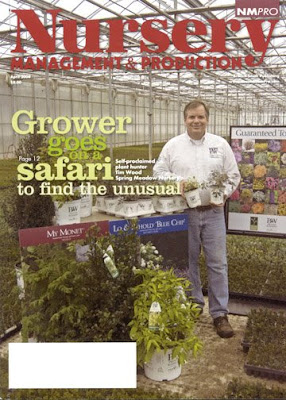
In one of my previous posts I asked everyone to complete a Hydrangea survey to give me a better idea what type of plants I should be looking for, breeding and introducing. The survey was primarily about Hydrangea macrophylla and its cultivars.
One comment that caught my attention went something like this:
I think instead of forcing Hydrangea macrophylla to do something they weren’t designed to do, we should focus the hardy species that bloom on new wood, like Hydrangea paniculata and Hydrangea arborescens. I agree, these two species are fabulous and foolproof just about anywhere in North America . There are many superb new varieties of Hydrangea paniculata. I've written about it on this blog and mentioned Pinky Winky, Little Lamb, The Swan, and Limelight. These are are all easy to grow and dependible plants.
One comment that caught my attention went something like this:
I think instead of forcing Hydrangea macrophylla to do something they weren’t designed to do, we should focus the hardy species that bloom on new wood, like Hydrangea paniculata and Hydrangea arborescens. I agree, these two species are fabulous and foolproof just about anywhere in North America . There are many superb new varieties of Hydrangea paniculata. I've written about it on this blog and mentioned Pinky Winky, Little Lamb, The Swan, and Limelight. These are are all easy to grow and dependible plants.
I also wrote about Hydrangea arborescens in an earlier post. To remind you I said …
Smooth Hydrangea, Hydrangea arborescens (Eastern U.S, Zone 3), is a wonderful, hardy plant that blooms in midsummer. It has the great advantage of blooming on the current season’s wood. This results in very reliable blooming plant regardless of frost or winter injury. The species itself is not a spectacular garden plant with its small mostly fertile flowers, but there are some noteworthy cultivars that are worth growing.
'Annabelle', introduced by Joe McDanials of Champaign, IL, is the most commonly grown cultivar. One is hard pressed to find any other cultivar of Hydrangea arborescens being sold today. There are some nurseries unknowingly selling the cultivars 'Hills of Snow' as 'Annabelle'. True 'Annabelle' has very large, perfectly symmetrical blooms, while the blooms of 'Grandiflora' are often quartered and irregular. 'Annabelle' is very showy, but often collapses under the weight of its own blooms.
If you remember, I said there was a need for more selections of H. arborescens and that I would like to see an improved 'Annabelle' with sturdier stems. At the time this was only a wish, however I was breeding and selecting with the goal of developeing an Annabelle with strong stems. Annabelle is such a great plant but is a mess after it rains. The stems are just not strong enough to hold the large flowers. Well I have exciting news to share; I found a plant with very strong stems. This was not a big of a surprise, but what came as a surprise was that this selection had strong stems and incredibly larger flower heads too. When I counted the individual flowers this selection had 4x as many flowers as Annabell. I call it Incrediball Hydrangea. Here are a few photos I took of the plant. What do you think?
Smooth Hydrangea, Hydrangea arborescens (Eastern U.S, Zone 3), is a wonderful, hardy plant that blooms in midsummer. It has the great advantage of blooming on the current season’s wood. This results in very reliable blooming plant regardless of frost or winter injury. The species itself is not a spectacular garden plant with its small mostly fertile flowers, but there are some noteworthy cultivars that are worth growing.
'Annabelle', introduced by Joe McDanials of Champaign, IL, is the most commonly grown cultivar. One is hard pressed to find any other cultivar of Hydrangea arborescens being sold today. There are some nurseries unknowingly selling the cultivars 'Hills of Snow' as 'Annabelle'. True 'Annabelle' has very large, perfectly symmetrical blooms, while the blooms of 'Grandiflora' are often quartered and irregular. 'Annabelle' is very showy, but often collapses under the weight of its own blooms.
If you remember, I said there was a need for more selections of H. arborescens and that I would like to see an improved 'Annabelle' with sturdier stems. At the time this was only a wish, however I was breeding and selecting with the goal of developeing an Annabelle with strong stems. Annabelle is such a great plant but is a mess after it rains. The stems are just not strong enough to hold the large flowers. Well I have exciting news to share; I found a plant with very strong stems. This was not a big of a surprise, but what came as a surprise was that this selection had strong stems and incredibly larger flower heads too. When I counted the individual flowers this selection had 4x as many flowers as Annabell. I call it Incrediball Hydrangea. Here are a few photos I took of the plant. What do you think?
Don't ask be where you can buy it because it's not for sale - yet. Hopefully you can get it from Wayside gardens next Spring.










